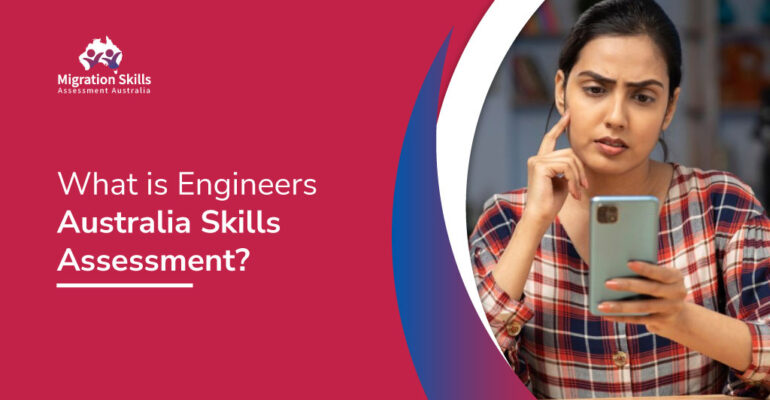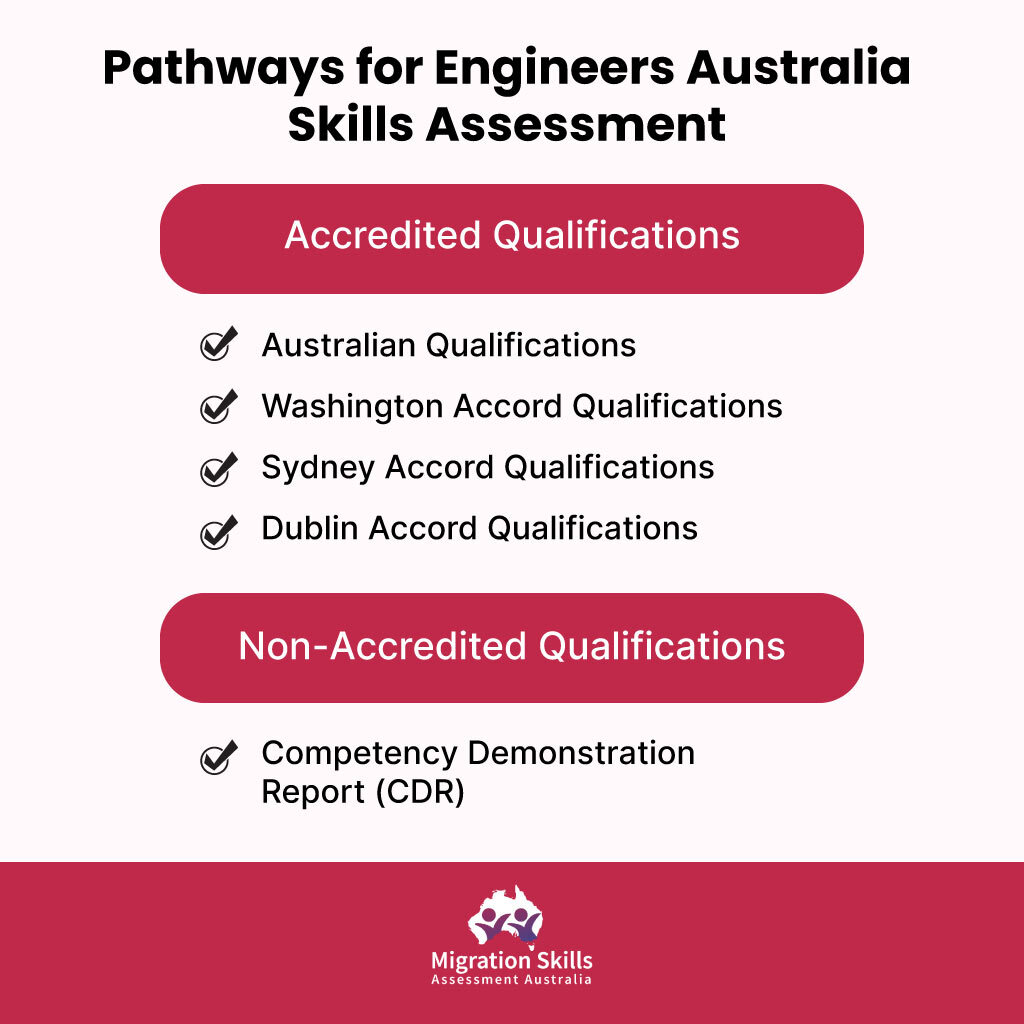What is the Engineers Australia Skills Assessment?

What is the Engineers Australia Skills Assessment?
If you’re an engineer who wants to work in Australia, the Engineers Australia Skills Assessment is your first big step. Engineers Australia is the granted authority that checks your qualifications, skills, and experience if you’re qualified to be an engineer in the country. They make sure you meet Australia’s high engineering standards. They’re also the ones who decide if engineers from other countries can work or move to Australia.
In this guide, we’ll explain the Engineers Australia Skills Assessment in detail, including the MSA booklet, CDR (Competency Demonstration Report), career episodes, assessment pathways, and how to apply. Our goal is to make this process easy for you to understand.
Importance of the Engineers Australia Skills Assessment
The Engineers Australia Skills Assessment holds immense significance for engineers for several reasons:
1. Migration Visa
You usually need a skilled migration visa if you’re an engineer from another country and want to live and work in Australia. The Engineers Australia Skills Assessment is a vital part of this process. It helps immigration authorities decide if you can work as an engineer in Australia.
2. Getting a Job
It’s essential to have a positive skills assessment from Engineers Australia if you’re an engineer from Australia or another country. In Australia, most employers prefer or even need candidates to have their qualifications and skills checked by Engineers Australia before offering them a job.
3. Professional Recognition
The Engineers Australia Skills Assessment helps with migration and employment and recognizes that you’re an experienced engineer in Australia. It shows employers and colleagues that you meet the high standards set by the engineering profession in the country.
Pathways for Engineers Australia Skills Assessment
Engineers Australia offers multiple pathways for the Skills Assessment to cater to engineers with diverse qualifications and experiences. Let’s explore these pathways in detail:

1. Accredited Qualifications
- Australian Qualifications: If you hold an engineering qualification from an Australian institution, it is considered accredited, making you eligible for this pathway.
- Washington Accord Qualifications: Engineers with qualifications recognized under the Washington Accord, an international agreement on engineering qualifications, can opt for this pathway.
- Sydney Accord Qualifications: Similar to the Washington Accord, this pathway is for engineers with qualifications recognized under the Sydney Accord.
- Dublin Accord Qualifications: Engineers with qualifications recognized under the Dublin Accord, yet another international agreement, can follow this pathway.
- Other Recognized Qualifications: This pathway may suit you if your engineering qualifications are recognized through other international agreements or equivalency assessments.
2. Non-Accredited Qualifications
- Competency Demonstration Report (CDR): The CDR route is essential for engineers with qualifications not covered by accredited pathways. This comprehensive report allows you to showcase your engineering competencies through examples of your work.
Read More: How to write a complete RPL Report for ACS skills assessment? ✈️✈️
Engineers Australia MSA Booklet
The Migration Skills Assessment (MSA) booklet is a comprehensive guide Engineers Australia provides. It is an indispensable resource for engineers undergoing the Skills Assessment process.
This booklet outlines the specific requirements, guidelines, and templates for preparing your CDR. It is paramount to carefully read and follow the guidelines in the MSA booklet to ensure your CDR meets the necessary standards.
Components of Competency Demonstration Report (CDR)
The Competency Demonstration Report (CDR) is crucial to the Engineers Australia Skills Assessment. It’s a detailed document where you can show your engineering skills with real examples from your work. Let’s look at the components of a CDR:
1. Career Episodes
Career Episodes are detailed narratives that describe specific engineering projects you’ve been involved in. Each Career Episode should highlight your role, responsibilities, and contributions to the project. It should also demonstrate how you applied engineering knowledge and skills to overcome all challenges and achieve project objectives.
Engineers Australia typically requires three Career Episodes.
- Writing Your Career Episodes: Each Career Episode must adhere to the format specified in the MSA booklet. This includes providing details on the project, your role, dates, and the objectives of the episode.
- Technical Writing Skills: Writing clear, concise, and technically sound Career Episodes is crucial. Engineers Australia assessors will scrutinize your ability to communicate your engineering experiences effectively.
- Avoiding Plagiarism: Plagiarism is strictly prohibited in CDRs. Ensure that your Career Episodes are your work, and reference any sources used appropriately.
2. Summary Statement
The Summary Statement is a cross-referencing document that links your engineering competencies with the specific paragraphs in your Career Episodes. It demonstrates how you meet the competency standards set by Engineers Australia. The MSA booklet provides a table format for creating the Summary Statement.
Read more: Engineering Jobs in Australia: A comprehensive list for Skills Assessment. 📑📑
3. Continuing Professional Development (CPD) List
The CPD list shows you’re dedicated to continuing your learning and professional growth in engineering. It should list the courses, workshops, seminars, or conferences you’ve participated in to improve your engineering knowledge and abilities.
Engineers Australia Skills Assessment Application Process
The application process for the Engineers Australia Skills Assessment involves several steps:
1. Eligibility Check
Before you start the application, ensure that you meet the eligibility criteria set by Engineers Australia. Typical eligibility requirements include having a relevant engineering qualification (according to the chosen pathway) and the least work experience in an engineering role.
2. Create an Online Account
Visit the Engineers Australia website and create an online account. This account will be used to present your application and track its progress.
3. Choose Your Engineering Occupation
Select the engineering occupation that aligns with your qualifications and work experience. Engineers Australia provides a list of engineering occupations to choose from.
4. Document Collection
Collect all the required documents, which may include:
- Academic transcripts and degree certificates
- Proof of English language skills (if required)
- MSA booklet
- Three Career Episodes
- CPD list
5. Application Submission
Complete the online application form thoroughly, attach the required documents, and pay the relevant fees. Engineers Australia will review your application and documents for compliance with their standards.
6. Technical Interview (if required)
In some cases, Engineers Australia may request a technical interview to assess your engineering knowledge and skills further.
7. Assessment Outcome
If your evaluation is approved, the EA assessor will email you an assessment outcome letter for immigration purposes. If you’ve made a visa application through a migration agent, they will provide you with a skills assessment verification letter. Engineers Australia has not imposed any restrictions on the validity period.
Nonetheless, it’s important to note that the Department of Home Affairs may have differing policies regarding the validity of assessments. If they request an updated letter, don’t hesitate to contact Engineers Australia for additional guidance and the necessary payment form to obtain an updated letter.
Read more: Engineers Australia Assessment Validity. 📑📑
Engineers Australia Skills Assessment Document Checklist
Ensuring you have all the required documents is crucial for a successful Skills Assessment application. Here is a checklist to help you organize your documents effectively:
- Academic transcripts and degree certificates: These should demonstrate your engineering qualifications.
- Curriculum Vitae (CV) or resume: Highlight your work experience, emphasizing your roles and responsibilities in engineering positions.
- Proof of English language proficiency: If you’re not a native English speaker, you may need to provide evidence of your language skills through tests like IELTS or TOEFL.
- Three Career Episodes: Each Career Episode should be a separate document detailing your engineering experiences in different projects.
- Summary Statement: Create this document per the MSA booklet guidelines. It should cross-reference your competencies with your Career Episodes.
- Continuing Professional Development (CPD) list: Compile a list of professional development activities and courses you’ve undertaken to enhance your engineering knowledge and skills.
Engineers Australia Skills Assessment Outcome and Validity
Understanding the outcome of your Skills Assessment is crucial. A positive outcome means that you meet the necessary standards for migration and employment in Australia as an engineer.
However, it’s essential to be aware of the validity period of your assessment, as it can significantly impact your visa application and job search. Engineers Australia’s assessments typically have a validity period, after which you may need to reapply if you still need to secure a visa or employment.
Review and Appeal Application
Suppose you’re happy with the result letter from your EA assessor; great! But if you’re unsatisfied with your assessment, there’s a way to address it. After that, you can request a review or an appeal. To ask for a review, you have to do it within three months of getting your result letter. Complete the “Application for Review of Outcome Letter” form and explain why you request a review in a cover letter.
During the review, you can only add new information you might have missed in your initial application. If you’re still unhappy after the review, you have another option: an appeal. You can submit an appeal application after you receive the review outcome letter.
You’ve got six months for the appeal from the day you got your original result letter. You’ll need to pay a fee when you submit your appeal application. This appeal process is the last step for reviews. Engineers Australia (EA) will give you a refund for the review and appeal fees if the outcomes match the original assessment letter and don’t require extra documents.
Learn More: Skillselect Visa Categories: Which Visa Pathway is Right for You? ✈️✈️
Why Choose Us for Your Skills Assessment?
We’ve been helping people with skills assessments from Engineers Australia for over ten years. Our team includes licensed and experienced writers who can help you create a CDR Report that meets your needs. We know the rules EA sets well and follow them closely to ensure your report gets a positive assessment from Engineers Australia.
At MigrationSkillsAustralia, we offer excellent services like CDR Report Writing, RPL Report Writing, and more, all designed to meet your requirements.
- Extensive Experience: MSA has years of experience assisting engineers with their Skills Assessment applications. They understand the intricacies of the process and can guide you effectively.
- Thorough Knowledge: MSA is well-versed in Engineers Australia’s requirements, ensuring that your application and documents align with their standards.
- CDR Expertise: MSA’s experts can provide invaluable assistance in preparing your CDR, ensuring it effectively showcases your engineering competencies.
- Supportive Guidance: MSA offers guidance and support throughout the process, from document preparation to application submission.
Conclusion
The Engineers Australia Skills Assessment is your gateway to a successful engineering career in Australia. You can confidently embark on your journey by understanding the various pathways, the importance of the MSA booklet, the components of a CDR, the application process, document checklists, and real-life examples.
Choosing MigrationSkillsAustralia as your partner in this endeavor can improve your chances of achieving a positive Skills Assessment outcome and realizing your dream of working as a professional engineer in Australia. Dedication and meticulous preparation are crucial to success in this rewarding endeavor.


